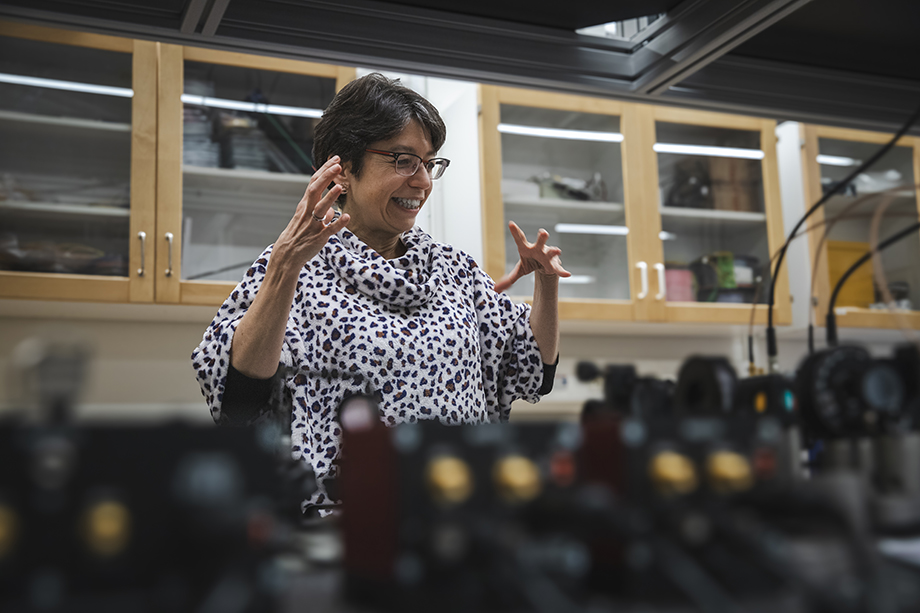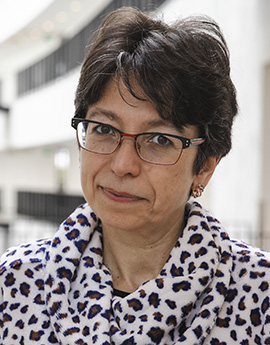Quantum communication could become the superpower of the future

Katia Gallo, Professor of Photonics, has always been fascinated by the combination of the laws of physics and engineering. She currently coordinates Sweden’s participation in a European initiative to build a quantum communication network.
“We are developing an infrastructure in Sweden that will eventually be linked with those of other EU member states,” she says.
The Swedish initiative, the National Quantum Communication Infrastructure (NQCIS), which is led by Gallo, was inaugurated earlier this year. Several other universities and a few companies are involved in the research project. The pilot facility at KTH will eventually serve as a test bed for companies, public authorities and organisations — a place to test and develop new products and services, and to explore how quantum communication could transform the way they work and communicate.
The project is being developed in two phases: first, each country will develop its own infrastructure, and later these networks will be interconnected and linked to satellites.
"Quantum communication is about building resilience, guaranteeing cybersecurity, strengthening Europe’s competitiveness, and fostering knowledge exchange with other nations, "says Gallo.
Reducing vulnerability
China, the United States, South Korea and the United Kingdom have made significant progress in developing quantum communication technology, and Sweden is well on its way too.
One of the great strengths of quantum technology, based on the behaviour of light particles (photons), is security — and, to some extent, speed. If someone tries to eavesdrop on or read the information being transmitted, the data is immediately altered, revealing any attempt at intrusion.
Today's digital systems are highly vulnerable, as evidenced by frequent news reports of leaked databases. Modern encrypted data, such as passwords, apps, chats, BankID and Zoom, could easily be cracked by a sufficiently powerful quantum computer in the future. Even now, encrypted data sent over the internet is vulnerable to 'collect now, decrypt later' attacks.
However, with QKD (quantum key distribution), communication becomes far more secure because it relies on the laws of physics rather than mathematical algorithms.
Barely noticeable to consumers
For everyday users, quantum communication is unlikely to be noticeable for the time being, since it will use the same fibre-optic network infrastructure as the internet does today. It will function more like a cloud service, and users may be able to subscribe to a quantum network in the future, offering unmatched security.
Potential application areas include finance, transportation, science and medicine, where classified or sensitive information needs to be shared.
The next step could be the creation of a quantum internet, leveraging another remarkable property of photons: their ability to exist in multiple places simultaneously. This feature is ideal for secure information transfer and quantum computing.
According to Gallo, one of the key challenges ahead is the development of quantum memory.
"We are also working on new components and protocols that will enable the transmission of photons' quantum properties over increasingly long distances — potentially up to 1,000 km without quantum repeaters."
But can any communication system really be completely secure?
"It depends on the nature of the threats.' Quantum technology offers an additional layer of security based on the laws of physics, which makes it super-secure in principle. However, it is how this 'superpower' is used that really matters. There’s still a lot of research and development to be done. Here at KTH, we’re working on integrated photonic circuits that deliver quantum capabilities in the form of miniaturised chips — components that can be incorporated into fibre networks and mobile communication systems. Almost without anyone noticing."
What will it be like to live in a quantum society?
"When advanced quantum networks become a reality and interact with classical computers, sensors and intelligent systems, information can be shared and managed between multiple parties, even wirelessly and over great distances," Gallo explains. That would make it possible to protect smart cities and self-driving vehicles from manipulation, maximise efficiency with minimal environmental impact and prevent attacks on digital services.'
"Ultimately, it’s just a technological tool — one with many advantages and remarkable properties. Much depends on how it’s used, which is why spreading knowledge about it is so important. Humans will still be at the centre — at least, I hope so."
And what about AI — isn’t that just another tool?
"Yes, but quantum technology doesn’t replace your intelligence or change the way you think."
Text: Jill Klackenberg (
jillk@kth.se
)
Photo: Christer Gummeson

